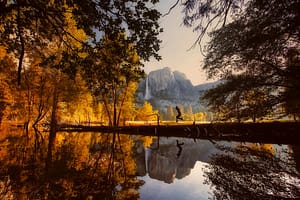The Ahwahneechee, a group of Miwok and Paiute peoples, lived in the Yosemite area for around 4000 years before a group of pioneers, most likely led by legendary explorer Joseph Rutherford Walker, came through in 1833. There were an estimated 3000 people living in 22 villages in the valley alone. During the gold-rush era, conflict between the miners and native tribes escalated to the point where a military expedition (the Mariposa Battalion) was dispatched in 1851 to punish the Ahwahneechee, eventually forcing the capitulation of Chief Tenaya and his tribe.
Tales of thunderous waterfalls and towering stone columns followed the Mariposa Battalion out of Yosemite and soon spread into the public’s awareness. In 1855, San Francisco entrepreneur James Hutchings organized the first tourist party to the valley. Published accounts of his trip, in which he extolled the area’s untarnished beauty, prompted others to follow, and it wasn’t long before inns and roads began springing up. Alarmed by this development, conservationists petitioned Congress to protect the area – with success. In 1864 President Abraham Lincoln signed the Yosemite Grant, which eventually ceded Yosemite Valley and the Mariposa Grove of Giant Sequoias to California as a state park. This landmark decision, along with the pioneering efforts of conservationist John Muir, led to a congressional act in 1890 creating Yosemite National Park; this, in turn, helped pave the way for the national-park system that was established in 1916.
Yosemite’s popularity as a tourist destination continued to soar throughout the 20th century and, by the mid-1970s, traffic and congestion draped the valley in a smoggy haze. The General Management Plan (GMP), developed in 1980 to alleviate this and other problems, ran into numerous challenges and delays. Despite many improvements, and the need to preserve the natural beauty that draws visitors to Yosemite in the first place, the plan still hasn’t been fully implemented.

